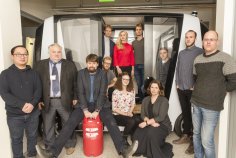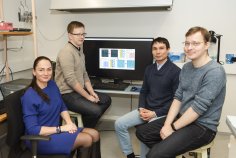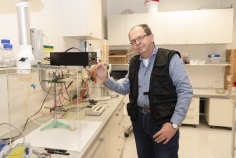Projects
Projects and Research Topics of the Institute of Chemistry
Analytical Chemistry Chair Projects
The Unified pH Scale: from Concept to Applications

PI: prof. Ivo Leito, Charit of Analytical Chemistry, University of Tartu
Project information: ETIS
Duration: 1.01.2020 - 31.12.2024
Acidity/basicity of liquid media strongly impacts chemical, biological, environmental and industrial processes. pH is the most widely used acidity measure of solutions/media. However, accurate evaluation of pH is currently possible only in a very limited range of media and pH values in different media are not comparable. This project will revolutionize pH measurement via putting a novel pH definition into practice, leading to better understanding and control of a variety of processes crucial in many real-world situations. An experimental absolute/unified pH scale valid in any medium (pHabs scale) and respective measurement methods will be developed that allow rigorous comparison of acidity between any liquid media. pHabs will be applied to 3 separate problems to demonstrate its capabilities: (1) accurate quantification of pH in highly acidic media, (2) evaluation of pH of solvent mixtures used in liquid chromatography, (3) rationalization of acid catalysis in low-polarity solvents.
Estonian Center of Analytical Chemistry
PI: prof. Ivo Leito, Charit of Analytical Chemistry, University of Tartu
Project information: ETIS
Duration:1.01.2021 - 31.12.2024
ECAC (AKKI, www.akki.ee) is a distributed interdisciplinary scientific research infrastructure, jointly created by UT, TalTech, Estonian Environmental Research Centre and National Institute for Chemical and Biological Physics. All fields of science and technology, from fundamental and applied research to product development and quality assurance, need the methods of chemical analysis. As a result, in order to coordinate and share analytical instrumentation, as well as specific know-how to Estonian research and industry, an online instrument sharing platform has been created. ECAC enables optimal use of analytical instruments, without unnecessary duplication. ECAC acts for researchers and industry as a contact point that covers most areas of analytical chemistry and enables reaching optimal instrument, service, or expert for the specific task at hand.
Excellence in Analytical CHemistry (EACH)
PI: prof. Ivo Leito, Charit of Analytical Chemistry, University of Tartu
Projest information: ETIS
Duration: 1.09.2020 - 31.08.2026
This international two-year joint Erasmus Mundus master degree programme, EACH – Excellence in Analytical Chemistry, educates specialists in analytical chemistry well qualified to work in industry (food, pharmaceutical, materials, energy, etc.) and chemical analysis laboratories (environment, food, health, etc.) worldwide. EACH provides knowledge and skills in both fundamental and applied aspects of modern analytical chemistry. The programme is taught by four universities: University of Tartu (UT, coordinator), Estonia; Uppsala University (UU), Sweden; University Claude Bernard Lyon 1 (UCBL), France; and Åbo Akademi University (AAU), Finland. The language of instruction is English, but students will also learn to communicate in one of the languages of the countries involved. Project nr: 586571-EPP-1-2017-1-EE-EPPKA1-JMD-MOB
Development of laser-based pen-type probe-MS system for the analysis of cultural heritage objects
PI: Assoc. prof. Signe Vahur, Charit of Analytical Chemistry, University of Tartu
Project information: ETIS
Duration: 1.01.2021 - 31.12.2025
The knowledge of the composition of the materials used in artefacts is important for history (elucidating the origin, age, authenticity of the artefact) and for conservation (to use suitable conservation materials). Due to their complex chemical composition and ageing, analysis of organic materials of artefacts, in terms of instrumentation, is challenging. In this project the main goal is creating the handheld laser-based pen-type sampling probe for the on-site mass spectrometric analysis of organic materials, under ambient conditions enabling to perform direct analysis on the surface of a solid object without specific sample preparation. This highly interdisciplinary project will engage chemists, physicists, engineers, conservation scientists, and archaeologists. Within this project the possibilities of the analysis of artefacts will be expanded. Beside in cultural heritage this universal tool could be exploited in forensics, pharmaceutics, etc.
Bernt Notke: The Research and Conservation of the Retable of the Church of the Holy Spirit
PI: prof. Hilkka Hiiop, Estonian Academy of Arts
Assoc. prof. Signe Vahur, Charit of Analytical Chemistry, University of Tartu
Project information: ETIS
Duration: 1.01.2019 - 31.12.2024
The main objective of the project is to conduct the research of Bernt Notke’s retable of the Church of the Holy Spirit, one of Estonia’s most prominent works of art, thereby broadening the knowledge of the context, use of materials, techniques and subsequent alterations made during the process of its creation. The general state and the damage will be documented and they will form the basis for conserving the retable. The innovative presentation of the collected information will contribute to a wider acknowledgement of this work of art in Estonia and abroad. Activities: *The research of creative practices and techniques and use of materials in the Baltic area in the late medieval era with the joint efforts of various (research) institutions in the name of a common goal – the appreciation of cultural heritage; *The presentation of Bernt Notke’s retable in the local as well as in the international context through scientific practices, web developments and popularization; *Integration of conservation and research practices into the curriculum of the Department of Cultural Heritage and Conservation of the Estonian Academy of Arts (organization of international workshops; involvement of students in the process of documentation, research and popularization); *Audience programmes for the wider general public. *The development of a web-based database to collect and present the outcomes of research and conservation.
Pots and bones, lipids and proteins: biomolecular archaeology for ancient dietary studies (PSG492)

PI: Assoc. prof. Ester Oras, Charit of Analytical Chemistry, University of Tartu
Project information: ETIS
Duration: 1.01.2020 - 31.12.2023
This project combines archaeology and analytical chemistry for investigating ancient dietary practices. We aim to significantly advance the understanding of ancient foodways by employing (a) combined multiproxy analysis of direct food-related archaeological material - pottery, human skeletal remains, faunal and botanical assemblages, and (b) testing novel cutting-edge instrumental techniques for analysing these dietary sources. Lipids and proteins as the best preserved ancient biomolecules in pottery and skeletal material will be studied to create comparative high-resolution and long-term overview of major developments and context-specific socio-cultural variations in prehistoric food consumption. Building on a wide selection of faunal and plant remains, over two hundred pots and hundred human skeletons covering the six millennia of prehistory, the most detailed and extensive overview of ancient Nordic dietary practices with unprecedented spatio-temporal coverage will be provided.
Unified pH values of photo- and electrocatalytic solvent systems
PI: research fellow Agnes Heering, Charit of Analytical Chemistry, University of Tartu
Project information: ETIS
Duration: 1.01.2022 - 31.12.2025
Electro- and photocatalysis in benign solvents is a promising direction of green chemistry. Catalytic CO2 reduction in its many variations (different reactions, solvents, catalysts) – is a prominent application of such catalysis. Acidity of the medium is a key parameter in catalysis. The most common measure of acidity is pH. Sadly, accurate pH measurements are mainly limited to dilute aqueous solutions. pH measurements in nonaqueous solvents (often used in electrocatalysis) are complicated and, most notably, pH values in different solvents are incomparable, which rules out comparisons of acidity-dependent processes between different solvents. This project will develop an experimental method based on the novel unified pH (pHabsH2O) concept that enables to directly compare the performance of catalytic processes between different media on the example of CO2 reduction. This in turn will lead to better understanding and support to further developments for industrial scale implementations.
Beyond paper-based microfluidics: towards real-world applications
PI: research fellow Hanno Evard, Charit of Analytical Chemistry, University of Tartu
Project information: ETIS
Duration: 1.01.2020 - 31.12.2023
In this project, crucial analytical capabilities – selectivity and sensitivity – of on-the-spot chemical tests will be radically improved. This will allow analytical chemistry to be applied in numerous on-site applications where existing techniques are not suitable. For example, it will be possible to perform wide screening of disease biomarkers in whole population (e.g. for heart failure) or on-the-spot analysis of drinking water (e.g. for lead contamination). Paper-based microfluidics is a promising novel technology that provides simple and inexpensive on-the-spot analysis capabilities but lacks analytical performance. Catalytic detection method (for high sensitivity visual detection) and alternative materials to paper (for enhanced selectivity) are used in novel ways to make the on-the-spot chemical tests applicable for real-life analysis. These novel developments will be used for detection of a widely used pesticide, glyphosate, from environmental water samples.
Other research directions in analytical chemistry
Bioorganic Chemistry Chair Projects
Rakendusuuring reproduktiivmeditsiinis kasutatavate rakuväliste vesiikulitel põhineva ravi ja analüüsi meetodite arendamiseks

PI: prof. Ago Rinken, Chair of Bioorganic Chemistry, University of Tartu
Project information: ETIS
EVREM (Extracellular Vesicles in REproductive Medicine) project’s main goal is to perform applied research which results will be the foundation of the development of the next-generation diagnostic tests in the field of reproductive & fetal medicine; to help infertile couples having children and to support pregnant women having healthy newborn.
Modular construction of organic materials with novel biomedical and luminescent properties (PRG454)
PI: prof. Asko Uri, Chair of Bioorganic Chemistry, University of Tartu
Project information: ETIS
Small molecules with distinct biological and photoluminescence properties will be combined to yield medium-sized (MW = 700 - 2500 Da) compounds with novel properties. Cellular uptake of the compounds will be achieved via incorporation of transporting modules or application of the prodrug approach. Compounds possessing picomolar affinity will be used for regulation of activity of mitotic protein kinases and anti-apototic kinase CK2. Rational combination of phosphorescent and fluorescent modules will be used for production protein binding-responsive ARC-Lum(Fluo) probes. The probes will be used for monitoring activity of mitotic kinases in live cells and development of multiplex assays for diagnosis of complex diseases. In solid polymeric matrixes ARC-Lum(Fluo) tandem luminophores reveal bright photoluminescence with slow signal decay. Properties of the luminophores will be optimized for construction of organic light-emitting devices, oxygen sensors, and devices for photodynamic therapy.
Frizzled receptor systems – lightening the black box with fluorescence methods (PRG230)
PI: research fellow Santa Veikšina, Chair of Bioorganic Chemistry, University of Tartu
Project information: ETIS
The WNT-FZD (Wingless/Int1-Frizzled) signalling system has a prevalent role during the embryogenesis. Furthermore, dysfunctions in this system are leading to diseases like cancer, bone disorders and neurological disorders. However, there is still lack of a direct method for quantification of ligand binding with full-length Frizzled receptors. Recently for a number of GPCRs we have proposed a simple solution with use of so-called Budded Baculovirus Surface Display methodology. The general aim of this project is development of new tools to study Frizzled receptor interactions with ligands. We intend to clarify the G protein subtype selectivity profiles for selection of Frizzled receptors and attempt to dissect the molecular features of the WNT/FZD pathway regarding signalling specification. Significant benefit is expected by using single molecule spectroscopy and microscopy techniques. We anticipate that our contribution would increase the possibilities of future drug development.
Other research directions in bioorganic chemistry
Physical and Applied Electrochemistry Chair Projects
Development of express analysis methods for micro-mesoporous materials for Estonian peat derived carbon supercapacitors (PRG 676)

PI: prof. Enn Lust, Chair of Physical Chemistry, University of Tartu
Project information: ETIS
Electrochemical and physical express testing methods of micro-mesoporous carbon synthesized from Estonian peat and complex materials completed electrodes will be developed. These simple testing methods will be verified by novel cutting-edge physical methods like small angle neutron scattering, operando synchrotron radiation photoelectron spectroscopy and X-ray absorption, visco-elastic spectroscopy, etc. methods. SANS and SAXS, HR-TEM EELS/SAED, Raman will be used for pore shape and chemical analysis of surfaces. Detailed porous structure analysis of carbon and complex materials will be conducted using nitrogen, CO2, Ar and Kr adsorption/absorption data using Carbon D- nonlocal density functional theory combined with heterogeneous surface, standard slit, Aspect Ratio 2;4;6 models. High power density supercapacitors will be completed using Estonian peat derived carbon compared with sugar and carbide derived carbons. Long-lasting electrochemical stability tests will be conducted.
Center of nanomaterials technologies and research (NAMUR+)
PI: assoc. prof. Vambola Kisand, Institute of Physics, University of Tartu
Partner: prof. Enn Lust, Chair of Physical Chemistry, University of Tartu
Project webpage: https://sisu.ut.ee/namurplus/
Project information: ETIS
The central goal of the Estonian Research Infrastructures Roadmap object “Center of nanomaterials technologies and research (NAMUR+)”, is to develop a cutting-edge infrastructure for the fabrication, research and implementation of nanomaterials and to merge it with the high-level research capability of the partners into an attractive multifunctional center providing R&D services in nanotechnology and nanosafety. NAMUR+ is based on the expertise of research teams of the University of Tartu, TalTech and National Institute of Chemical Physics and Biophysics in the fields of material science, nanotechnology, nanotoxicology, and novel energy conversion and storage systems. The center offers high-level research services in nanotechnology and nanosafety to a wide range of partners, including private sector.
Novel sulphur-tolerant fuel electrodes for reversible solid oxide cell (PRG551)

PI: assoc. prof. Gunnar Nurk, Chair of Physical Chemistry, University of Tartu
Projekct information: ETIS
Reversible solid oxide cell is an energy conversion system, which enables to effectively store wind or solar energy. Until now, the large-scale utilisation of these systems has been hindered by high system production prize and limited durability. The aim of this project is to develop sulphur- and carbon-tolerant electrodes, which enable cost-effective utilisation of bio- or oil shale gas in the solid oxide cell. For this purpose ceramic peovskite type mixed ionic electronic conductive electrodes will be activated with nanoparticles of Ni-Sn, Ni-Cu ja Ni-Mo catalytic metal alloys. To obtain detailed information about catalyst interface, i.e. for detailed analysis of dependence between crystallographic structures, chemical composition and electrochemical activity of electrodes, novel operando high temperature X-ray diffraction and X-ray photoelectron spectroscopy methods will be used.
Analysis of novel model surfaces for molecular technology (PSG249)

PI: research fellow Piret Pikma, Chair of Physical Chemistry, University of Tartu
Project information: ETIS
Nowadays all electronic devices like phones, computers, etc. have a trend to be miniaturised, but at the same time offering a higher level of performance. Hence the importance of molecular technology – if the size of a single transistor would be one molecule then it would be possible to save a million times more data to a cm-sized chip than today. As a solution, single molecule junctions have been suggested as potential building blocks of miniaturized electronics. The main aim of this study is to find novel alternatives to noble metal model surfaces in molecular electronics. In situ scanning tunnelling microscopy imaging and break-junction techniques combined with electrochemical methods will be used to study the possibility to applicate recycled cadmium and nickel from cadmium-nickel batteries in molecular memory modules. Thus, finding a cost-effective alternative to noble metals, e.g. gold, and implementing green thinking by using recycled materials.
Other research directions in physical chemistry and applied electrochemistry
Chemical Physics Chair Projects
Synthesis in charged droplets (PRG300)

PI: prof. Peeter Burk, Chair of Chemical Physics, University of Tartu
Project information: ETIS
Synthesis of new compounds is essential for a majority of technologies from material science to medicine. Despite the great benefits provided by the development of novel catalysts, several reactions still remain problematic in organic synthesis. We propose overcoming such limitations by carrying out organic reactions in charged droplets. Charged droplets have several properties that are complementary to conventional synthesis media; namely, they possess superacidic or superbasic properties, violate electroneutrality, and allow protonation of functional groups not accessible in the liquid phase. Recently, it has been observed that chemical bonds are formed in an accelerated manner in charged droplets. In this project, we will direct and discover new reaction pathways in charged droplets in order to overcome throughput-limiting steps in pharmaceutical synthesis.
NanoInformatics Approaches for Safe-by-Design NanoMaterials (EU H2020, CompSafeNano)
PI: Kaido Tämm, Chair of Chemical Physics, University of Tartu
Project information: ETIS
The unique properties of nanomaterials (NMs), relative to their bulk form, has seen them used in a rapidly increasing number of commercial applications. However, with these useful new properties of NMs come potential health and environmental hazards. Thus, as part of a responsible innovation approach, NMs potential risks must be assessed in parallel to exploitation of their benefits. Due to their enormous variability, NM risk assessment urgently needs advanced in silico methodologies capable of machine learning from limited experimental datasets. These in silico tools for NMs characterisation, exposure, hazard and risk assessment and sustainability and life cycle assessment, need to support implementation of existing regulatory guidelines and extend regulatory risk assessment to integrate the extensive new knowledge generated computationally. CompSafeNano’s overarching objective is thus to drive the development of integrated and universally applicable nanoinformatics models, with broad domains of applicability across NMs compositions and forms, that are directly usable by industry, especially SMEs, and regulators for NMs risk assessment and decision making. CompSafeNano will establish an extended safe-by-design paradigm that includes environmental sustainability (life cycle assessment) based on in silico predictions with experimental testing to validate the results. CompSafeNano has a clear set of objectives to deliver this vision of an in silico safe-by-design computational platform and will be in close communication with other EU projects to access existing data on NM hazard and integrate existing nanoinformatics and NMs risk governance platforms (i.e. within NanoCommons, NanoSolveIT & RiskGONE). Training activities will benefit both ESRs and ERs from participating organizations, with a strong focus on inter-sectoral exchange (SME-academia) and international collaboration, filling the wellrecognised current skills gap in nanoinformatics and big data analytics.
Innovaatilised ja integreeritud nanoinformaatika mudelid ja moodulid (öko)toksikoloogiliste parameetrite ennustamiseks (EU H2020, NanoSolveIT)
PI: Kaido Tämm, Chair of Chemical Physics, University of Tartu
Project information: ETIS
NanoSolveIT aspires to introduce a groundbreaking in silico Integrated Approach to Testing and Assessment (IATA) of the environmental health and safety of Nanomaterials (NM) that will be implemented through a decision support system packaged as both a stand-alone open software and via a Cloud platform. NanoSolveIT will develop and deliver: (i) a reliable user friendly knowledge-based infrastructure for data hosting, sharing and exploitation, (ii) NM fingerprints, i.e., sets of nanodescriptors and properties that can be predictively linked to NM functionality, exposure and hazard thereby supporting NM grouping, safe-by-design (SbD) and regulatory risk assessment (RA), (iii) innovative methodologies for NMs predictive (eco)toxicology underpinned by artificial intelligence (AI) and state-of-the-art in silico techniques, and, (iv) integration with currently developing multi-scale modelling, RA and governance frameworks. NanoSolveIT will develop and deliver a validated, sustainable, multi-scale nanoinformatics IATA, tested and demonstrated at TLR6 to serve the needs of diverse stakeholders at each stage of the NMs value chain, for the assessment of adverse effects of NM on human health and the environment.
Development of novel drug candidates for Parkinson’s disease (GDNF Mimetics: From Hit to Lead)
PI: Kaido Tämm, Chair of Chemical Physics, University of Tartu
Project information: AS Genecode https://www.genecode.com/
The very recent GDNF proteiin trials indicate that GDNF is the first agent that demonstrates the ability to slow down disease progressioon in Parkinson's disease, whilst existing PD treatments only alleviate symptoms and are unable to decelerate, stop or reverse neurodegeneration and disease progression. However, the treatment of PD with GDNF is not optimal owing to the fact that it is a protein that does not cross the blood-brain barrier and must be delivered to the patient during brain surgery. Small molecules that activate GDNF receptors developed by University of Tartu and GeneCode Ltd. can be used to overcome these difficulties. The goal of the project is to find lead compounds and progress them along the drug development pipeline until they are at IND-ready status. Enterprise Estonia supports the project with a research and development scholarship of 2 million euros.

National Competence Centres in the framework of EuroHPC
PI: Ivar Koppel, Institute of Computer Science, University of Tartu
Partner: Kaido Tämm, Chair of Chemical Physics, University of Tartu
Project information: ETIS
The EuroHPC competence center (EuroCC) activity will bring together the necessary expertise to set up a network of National Competence Centres in HPC across Europe in 31 participating, member and associated states, to provide a broad service portfolio tailored to the respective national needs of industry, academia and public administrations. All of this to support and increase strongly the national strengths of High Performance Computing (HPC) competences as well as High Performance Data Analytics (HPDA) and Artificial Intelligence (AI) capabilities and to close existing gaps to increase usability of these technologies in the different states and thus provide a European excellence baseline.
Other research directions in chemical physics.
Colloid and Environmental Chemistry Chair Projects
Efficient catalyst materials for electrochemical energy technology related applications (PRG723)

PI: prof. Kaido Tammeveski, Chair of Colloid and Environmental Chemistry, University of Tartu
Project information: ETIS
For future electric vehicles and renewable energy-based economy novel energy conversion and storage devices are needed. Fuel cells (FCs) and metal-air batteries (MABs) are some of the most promising technologies and massive efforts are put into development of these by the electrochemical community. To date, expensive catalysts based on noble metals are used in these devices to accelerate the electrochemical oxygen reduction reaction or the oxygen evolution reaction. Replacing these with non-precious metal catalysts (NPMCs) would enable them to truly break through to the market. This project aims to develop novel nitrogen- and transition metal-containing carbon nanomaterials as NPMCs for low-temperature FCs and MABs from cheap materials. Rational design of catalysts derived from correlations between electrochemical results and physicochemical characterisations will enable to select suitable inexpensive precursors and optimise synthesis conditions to create highly efficient catalysts.
Developing strategies for atomically dispersed non-precious metals as efficient bifunctional electrocatalysts for oxygen reduction and evolution reactions
PI: prof. Kaido Tammeveski, Chair of Colloid and Environmental Chemistry, University of Tartu
Project information: ETIS
The global climate changes caused by fossil fuel-based technologies demand clean energy solutions viz. fuel cells and metal-air batteries. The state-of-the-art Pt catalysts suffer by stability and scarcity issues in their wide range of applications. In this view, several alternative approaches are being studied, still remains as big challenge to penetrate them to the practical applications. In this regard, single atom catalysts (SACs) are alternative choices to replace costly Pt with their excellent catalytic activity. The atomically dispersed metals supported on nanocarbon materials fetch many adverse effects, which are advantageous to develop novel catalysts for electrochemical energy conversion and storage devices. Synergistic effects between SACs and support are crucial to enhance their electrocatalytic performance. It unlocks a novel path for catalyst design and synthesis, wherein series of binary SACs with better catalytic properties are yet to be designed in a successful route.
New metal–organic coordination network based materials as multifunctional electrocatalysts for energy conversion and storage (PSG250)
PI: assoc. prof. Nadežda Kongi, Chair of Colloid and Environmental Chemistry, University of Tartu
Project information: ETIS
I propose to develop new classes of electrocatalyst materials for their use in sustainable energy conversion and storage devices. Motivated by the urgent need for improved, earth-abundant-based (i.e. Pt-free) catalysts, I aim to design and evaluate an original set of metal-organic coordination network (MOCN) based electrocatalysts. This will be accomplished by customization of catalyst structures, involvement of different earth-abundant metals and developing the knowledge-based design of the electrocatalytically active sites. Multifunctional ability to efficiently catalyze simultaneously different oxygen and hydrogen electrochemical reactions will be explored by using state-of-the-art electrochemical techniques combined with physical morphological characterisation and theoretical modelling methods. The most promising catalysts will undergo practical performance tests.
Identifying best available technologies for decentralized wastewater treatment and resource recovery for India
PI: assoc. prof. Taavo Tenno, Chair of Colloid and Environmental Chemistry, University of Tartu
Project information: ETIS
The aim of SARASWATI 2.0 is to identify best available and affordable technologies for decentralized wastewater treatment with scope of resource/energy recovery and reuse in urban and rural areas. Further, it addresses the challenge of real time monitoring and automation. The previous SARASWATI project has shown that a number of decentralized wastewater treatment plants in India do not perform properly and that there are few plants that would meet the more stringent standards as those proposed by the Indian Government in 2015. Thus, in many cases not even CATNAP (the cheapest available technology narrowly avoiding prosecution) has been applied, leading to high pollution levels. The SARASWATI project therefore proposed to adopt the principle of BAT (best available technologies) in a more flexible way, adapting the definition of BAT to the local context, based on complementing the treatment efficiency with the costs of the treatment technology and affordability, and local context in the location of application. This will allow to identify BATs with more stringent standards if required and suitable for the location. Thereby, ten pilot technologies in 7 Indian States demonstrating enhanced removal of organic pollution (BOD, TSS), nutrients (particularly Nitrogen), organic micro-pollutants and pathogens have been proposed (WP1). Further, all pilots allow for resource recovery contributing to the principles of a circular economy and will undergo a comprehensive performance assessment (WP2) complemented by an extended sustainability assessment informed by recent ISO standards (WP4). This will allow identification of BATs for the Indian context. In addition, suitable automation and control strategies will be tested and recommended, taking into account the presence of operators and their level of knowledge and expertise (WP3). Finally, WP5 is dedicated to dissemination and exploitation of results. The consortium is comprised of a well-balanced EU-Indian team of 18 partners.
Other research directions in Colloid and Environmental Chemistry
Molecular Technology Chair Projects
Therapeutic ligands for RNA-epigenetic enzyme targets
PI: emer. prof. Mati Karelson, Chair of Molecular Technology, University of tartu
Project information: ETIS
This project aims to identify and characterize high-affinity ligands for RNA-epigenetic modifying enzymes. The target enzymes are 1) m6A methylases (writers): METTL3, METTL14, 2) m6A-demethylases (erasers): FTO, and 3) m6A readers: YTHDC1. Identification of the ligands is carried out by virtual screening of large compound libraries; the prospective ligands will be resynthesized and chemically characterized for further biological testing.
Data driven modelling of physical-chemical-biological properties of complex molecular environments and functional materials (PRG1509)
PI: assoc. prof. Uko Maran, Chair of Molecular Technology, University of Tartu
Project information: ETIS
The motivation and purpose of this project is to advance our understanding of molecular interactions and mechanisms in complex environments and functional materials of practical interest. This is accomplished through data-driven modeling and design that gives explanatory view of physical-chemical-biological processes under investigation and their mechanisms at the molecular level that are not otherwise discoverable. This requires a coherent approach to experimentation and modeling, which would allow knowledge of interactions and mechanisms to be extracted in model-informed manner and would help to identify "hidden" relationships between measured data and chemical and material structure. For example, the proposed research will add new data and model-informed knowledge to better understand drug substances transport in different environments, or how physico-chemical interactions affect the behavior of electrolytes in nanoporous carbon materials, etc.
Partnership for the Assessment of Risk from Chemicals (PARC)

PI: assoc. prof. Uko Maran, Chair of Molecular Technology, University of Tartu
Project information: ETIS
The scope of the Partnership for the Assessment of Risk from Chemicals (PARC) is to stimulate research and innovation in chemical risk assessment (RA) through a common roadmap set by risk assessors and risk managers in consultation with all stakeholders (academia, industry, associations and others) to enable risk assessors and risk managers to respond to current and future challenges. The general objective is to consolidate and strengthen the EU's research and innovation capacity for chemical risk assessment to protect human health and the environment and contribute to a non-toxic environment and a circular economy. The overall aim of this activity is to promote and facilitate the regulatory acceptance and practical use of new approach methods (NAM-s) in chemical risk assessment. Emphasis is put on data quality and on real-life situations and application contexts encountered by risk assessors, with complex modes of action and/or often severe knowledge gaps. We will also focus on the status of integration and use of data sciences (i.e. artificial intelligence (AI), machine learning (ML) technologies, decision support systems (DSS)) in the regulatory context, as well as on barriers, opportunities and drivers for success towards the development, validation, and implementation of computer-based approaches for knowledge-driven/evidence-based risk assessment frameworks. The ultimate goal is to support the introduction of next generation risk assessment (NGRA) methods and tools across regulatory domains.
Bioactive chemical space for cervical cancer: cheminformatics analysis of chemical structure patterns, machine learning modelling of diverse chemical space and discovery of new bioactive structures
PI: teadur Selma Zukić, Chair of Molecular Technology, University of Tartu
Partner: assoc. prof. Uko Maran, Chair of Molecular Technology, University of Tartu
Project information: ETIS
Within cancers, cervical cancer is one of the leading causes of cancer-related deaths affecting women worldwide. Measuring antiproliferative activity against HeLa cervical cancer cell line makes this endpoint key source of data for the modelling of antiproliferative activity and design of new chemistries. This project aims to: (i) establishing complete overview of HeLa experimental measurement of cervical cancer and chemical space related to that; (ii) study molecular relationships (networks) within the chemical space of collected data; (iii) analyse and develop in silico (machine learning, artificial intelligence, etc) models for collected large and diverse dataset of compounds with antiproliferative activity; (iv) study ligand-protein molecular interactions with aid in gaining more information of molecular mechanism at active sites; (v) use derived models to rank known chemical for antiproliferative activity; and finally experimentally validate top ranked molecules.
Other research directions in Molecular Technology.
Neuropsychopharmacology Chair Projects
Gene Environment interactions in Mental health trajectories of Youth (Youth-GEMs)
PI: prof. Jaanur Harro, Chair of Neuropsychopharmacology, University of Tartu
Project Information: ETIS
Youth mental health is heavily burdened, with life-long enduring impact on European citizens and societies. Trajectories of mental health and illness in young people are assumed to be determined by interplay between genetic, epigenetic, and environmental risk impacting during development. However, direct evidence for this is sparse and scientific progress is challenged. We recently initiated substantial advances enabling us to create necessary breakthroughs at the most pressing needs and challenges. Aiming to significantly reduce mental suffering and illness among European youth within the next 5-10 years, we will provide 1) the world’s first evidence-based knowledge base of functional (epi)genomics of the developing post-natal human brain in direct relation to developmental trajectories of trans-diagnostic phenotypes of mental illness, providing improved risk markers and actionable biological targets, 2) reliable predictive models, while identifying gene-environment interplay, as well as early (actionable) markers of trajectories of mental (ill)health in young people through the use of artificial-intelligence-based and inference-based analyses of the largest sets of longitudinal general population datasets to date (from Europe, United Kingdom, Australia and the United States), 3) the first comprehensive, validated set of evidence-based biologically, socially and psychologically-informed instruments for the robust quantitative clinical assessment of mental health for help-seeking youth between age 12 and 24, harmonised across European and Australian settings, and 4) youth- and clinician-empowering instruments for early (self)detection and prediction of mental ill-health of trajectories in youth. Our multidisciplinary consortium is uniquely equipped and positioned to enforce the necessary breakthroughs for significant reduction of mental illness and suffering of youth, and to translate our findings into clinical innovation and life-long impact in Europe and beyond.
Neurobiology of adaptive strategies: The relationship of vulnerability and pathogenesis, and its significance for behavioural neuroscience and precision medicine
PI: prof. Jaanur Harro, Chair of Neuropsychopharmacology, University of Tartu
Project Information: ETIS
Disorders of the function of the brain place an enormous burden on the society in the form of psychiatric disorders as well as problem behaviours. Research proposed herewith advances precision medicine by specifying the neural underpinnings of distinct major adaptive strategies, and by examining separately mechanisms that underlie vulnerability to disorder and pathogenesis of disorder. This is done taking advantage of both innovative animal models and longitudinal human studies by multidisciplinary use of modern methods of neurobiology and data analysis. Our recently forged pioneering intervention techniques, again both in animal models and in humans, will be tapped to clarify the biological basis of vulnerability, adaptive strategies and sensitivity to intervention, and further developed. We expect to create a novel strategy to treat and prevent chronic, relapsing brain disorders, and algorithms to suggest tailored intervention methods to mitigate harm caused by impulsive action.
Effects of Nutrition and Lifestyle on Impulsive, Compulsive, and Externalizing Behaviours
PI: prof. Jaanur Harro, Chair of Neuropsychopharmacology, University of Tartu
Project Information: ETIS
Maladaptive impulsivity and compulsivity predispose to antisocial and addictive behaviours. Factors influencing those traits are not well understood, but diet, lifestyle, socioeconomic status (SES), sex, and heritability play pivotal roles. Here, we aim (1) to identify nutrition and lifestyle drivers that can be employed to prevent detrimental impulsivity/compulsivity in males and females across the lifespan, (2) to characterize the etiologic paths leading to extreme behaviour, and (3) to promote policy changes to counteract maladaptive impulsivity/compulsivity by disseminating evidence-based information about health-related behaviours to families, clinicians, policy makers, and general public. We use epidemiologic approaches in the world-wide largest existing samples to investigate association of nutrition components & lifestyle with impulsivity/ compulsivity, and how such associations are moderated by age, culture, sex, SES, and genetics. We assess beneficial effects of key nutritional interventions through RCTs in highly impulsive males/females, going beyond state-of-the-art by directly comparing personalized, high-intensity approaches with one-size-fits-all and microbiome-dependent supplementations. We study the protective potential of acute exercise and habitual physical activity. We monitor intervention-induced changes in real time through objective mHealth-based experience sampling. Uniquely, we study effects of the gut-microbiome and its metabolites, as well as brain connectivity and epigenetic patterns as mediators and predictors of behavioural change. We initiate and support societal change by media-based information and education. We innovate the field by measuring behavioural change using social media downstream of educational campaigns and by translation of our findings into tangible healthy food solutions with a celebrity chef. Our group, in which experts from multiple disciplines join forces, is in a unique position to carry out the proposed project.
Organic Chemistry Chair Projects
Binding properties of receptor peptides against CoV2 virus S1 protein

PI: prof. Jaak Järv, Chair of Organic Chemistry, University of Tartu
Project information info: ETIS
Based on previously developed materials and the existing analytical device, the binding of sensor peptides to the virus CoV2 S1 protein is investigated. The result of this work is a summary of the binding properties of sensor peptides and the selection of further developments for the development of a virus detection chip. Based on the results of the work, the next research project to create a CoV2 virus tester will be started.
Technologies for chemical and enzymatic valorization of lignin: products from lignin and its phenolic fragments – starting compounds for synthesis of materials, resins, adhesives, plastics, building materials
PI: Siim Salmar, Chair of Organic Chemistry, University of Tartu
Project information: ETIS
More than 90% of wood carbon can be potentially valorized to produce high-value chemicals and materials, and effective lignin valorization would yield about 10 times more value as compared to using it for energy production. The focus of the project is to explore the possibilities for valorization of a novel type of hydrolysis lignin (HL) produced by Estonian wood industry with the aim to provide alternatives for fossil-based chemistry. We will use non-conventional chemical and physical approaches: ultrasound, flow chemistry, wood-based solvents for HL solubilization, fractionation, depolymerization and modification. Solubilized HL will be modified using enzymatic and biological methods. As a result of the R&D activities, we aim to develop processes for production of polyuretan, polyphenol, lgnin-polylactide, etc. materials. The project will further develop the wood chemistry and bioprocessing platform at TU, includes new competences, human resources, and cooperation with industry.
Chemical and biological valorization of lignin
PI: prof. Mart Loog, Faculty of Science and Technology, University of Tartu
Partner: Siim Salmar, Chair of Organic Chemistry, University of Tartu
Project information: ETIS
Other research directions in Organic Chemistry.



